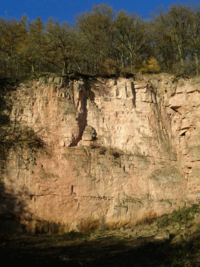Tag:geological=outcrop
| Description |
|---|
| A place where the bedrock or superficial deposits previously covered under the soil have become locally exposed |
| Group: natural |
| Used on these elements |
| See also |
| Status: in use |
| Tools for this tag |
|
An ![]() outcrop site is a place where the bedrock or superficial deposits previously covered under the soil have become locally exposed and are directly accessible to analysis. This can be due to tectonic movements, erosion from wind or precipitation or changes in vegetation, or even by excavation.
outcrop site is a place where the bedrock or superficial deposits previously covered under the soil have become locally exposed and are directly accessible to analysis. This can be due to tectonic movements, erosion from wind or precipitation or changes in vegetation, or even by excavation.
See also natural=bare_rock which is widely used for any areas of visible bedrock.
Examples
It may help to look at some examples of common types of outcrops, as it is not always obvious what it means for a rock to be attached to the underlying bedrock or where you might find it.
One of the most common types of outcrops in built-up environments and along street-level features are "road cuts." This describes rock outcrops which were exposed by the building of a road. (Outcrops can be exposed by the building of a parking lot, golf course, railway; with any of these man-made activities something similar to a road cut can be exposed.) These are often considered particularly notable points of interest, because they can reveal parts of the Earth which would not normally get exposed by a natural process (or would always be covered by vegetation/soil otherwise), and because they are much more accessible than most geologic features.
Another very common place to find outcrops is along bodies of water. This could include things like cliffs at beaches or rocky river banks.
Outcrops can also be found exposed in a variety of ways surrounded by natural landcover. These are more common in drier climates with less vegetation cover, but rock outcrops formed from previous tectonic events can be seen exposed in various vegetated areas too. Typically an outcrop would be distinguished from the type of rocky surface surroundings mapped with natural=bare_rock if it is elevated from its surroundings in some way.











